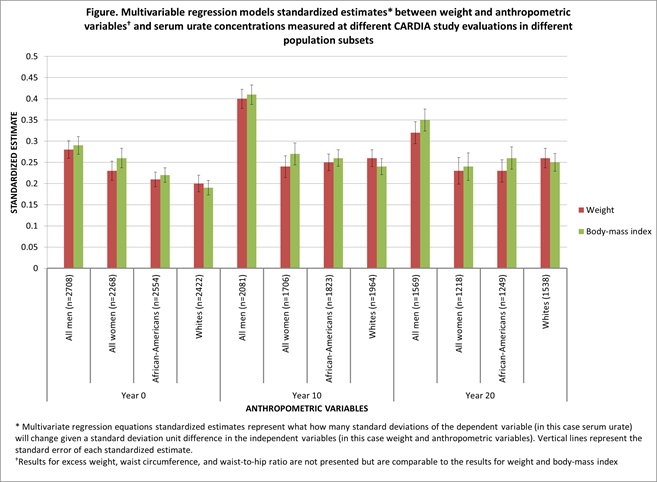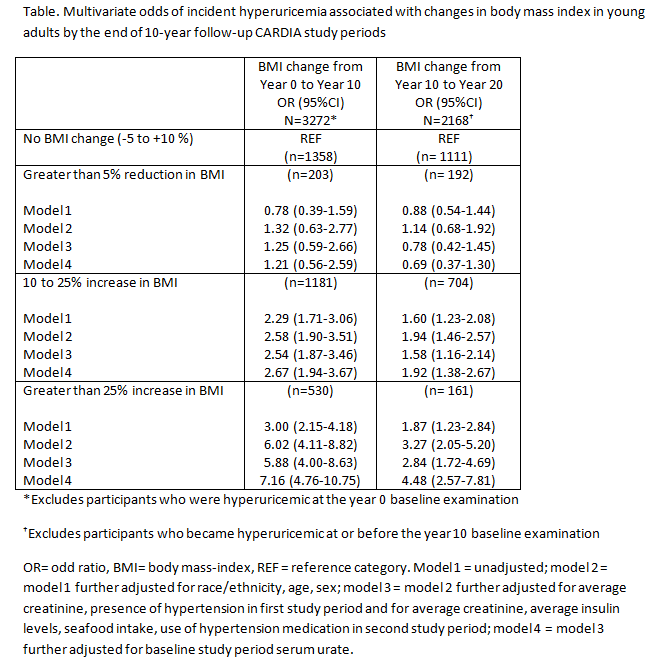Session Information
Session Type: ACR Poster Session A
Session Time: 9:00AM-11:00AM
Background/Purpose: How body weight, anthropometric parameters, and their changes are associated with serum urate concentrations and hyperuricemia remains unclear. The CARDIA study has been following young adults for 25 years and has detailed anthropometric data along with serum urate levels at multiple follow-up examinations. The present analysis aims to describe the association of weight and anthropometric variables with serum urate and hyperuricemia in young and middle aged-adults.
Methods: We performed multivariable linear regression analyses to determine if weight and anthropometric variables (body mass index [BMI], excess weight, waist circumference, hip circumference, waist to hip ratio) and their changes were associated with serum urate and serum urate changes. In addition, we analyzed associations between changes in BMI and development of incident hyperuricemia using logistic regression during the first and second 10-year periods of CARDIA follow up. We excluded participants with missing serum urate information or missing covariate data (renal function, serum insulin levels, dietary data, alcohol intake, hypertension) from analyses.
Results: Mean age of the study population at enrollment was 24.8 years. At baseline (n=4976) 46% of the included CARDIA populations were women and 51% were African-Americans. Weight and body mass index were associated with serum urate concentrations with comparable strengths at different points in the overall populations, but on later exams (Years 10 and 20 of follow-up) these associations were stronger for men than for women (Figure). Throughout the study, changes in BMI were associated with a small but significant 9-10% of the variance (partial r2) in serum urate change. In the first 10 years of follow-up, participants who gained more than 25% BMI had a 7.2 fold increased odds (95% confidence interval 4.8-10.8) of incident hyperuricemia after full multivariable adjustment when compared with participants who kept a stable BMI. Losing more than 5% BMI wasn’t negatively associated with hyperuricemia during the same study period. Similar results, but of smaller magnitude, were found for BMI changes during starting at year 10 until year 20 (Table).
Conclusion: Weight and body mass index were associated with serum urate concentrations at similar magnitudes. Although BMI changes seem to explain a small proportion of the variance in serum urate change in young adults, gains in BMI during young adulthood are independently associated, in a dose-response fashion, with significantly increased odds of developing hyperuricemia.
To cite this abstract in AMA style:
Gaffo AL, Jacobs DR Jr., Wang H, Saag KG. Weight Variables and Their Association with Serum Urate Concentrations and Hyperuricemia in Young Adults [abstract]. Arthritis Rheumatol. 2015; 67 (suppl 10). https://acrabstracts.org/abstract/weight-variables-and-their-association-with-serum-urate-concentrations-and-hyperuricemia-in-young-adults/. Accessed .« Back to 2015 ACR/ARHP Annual Meeting
ACR Meeting Abstracts - https://acrabstracts.org/abstract/weight-variables-and-their-association-with-serum-urate-concentrations-and-hyperuricemia-in-young-adults/


